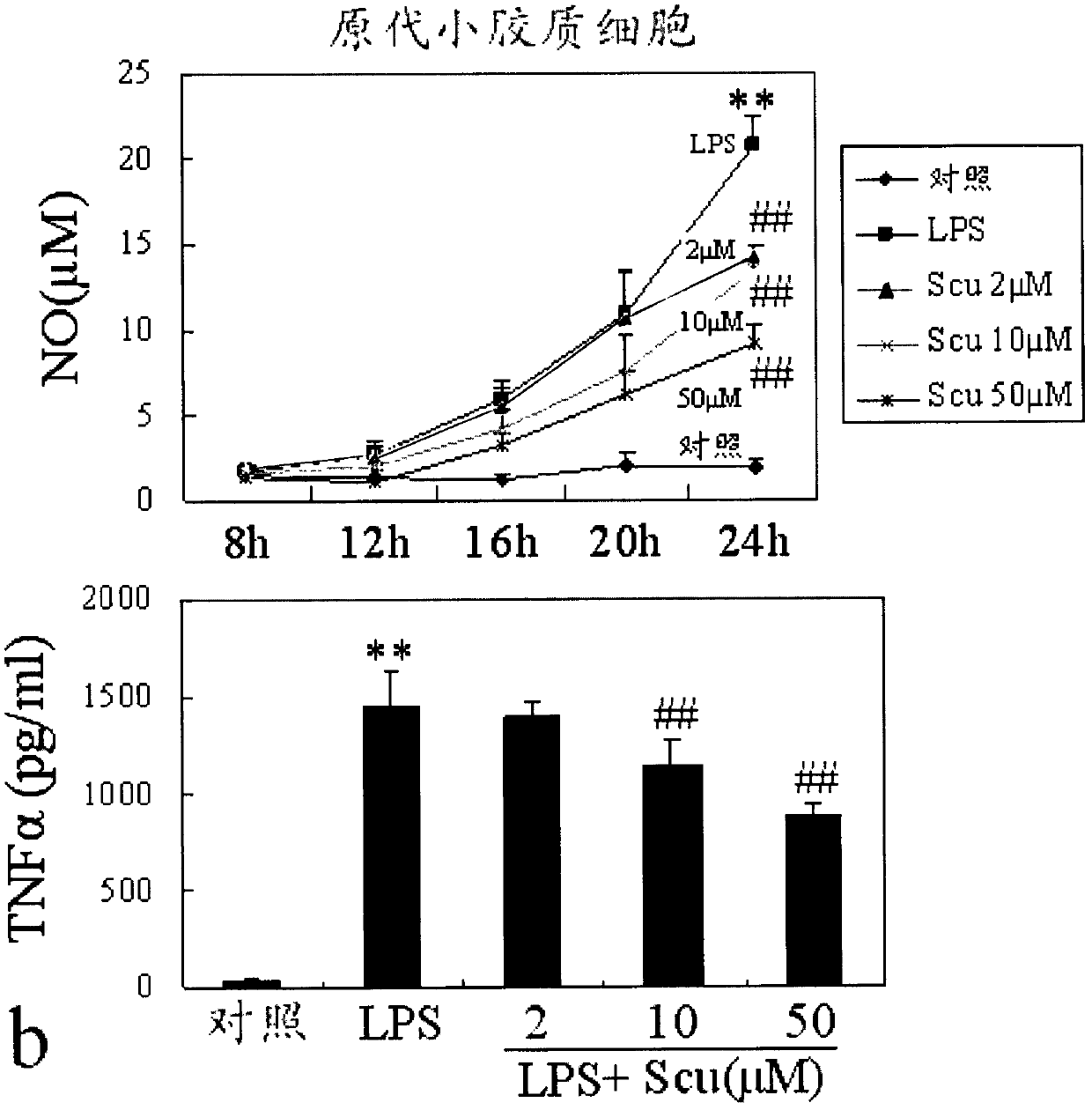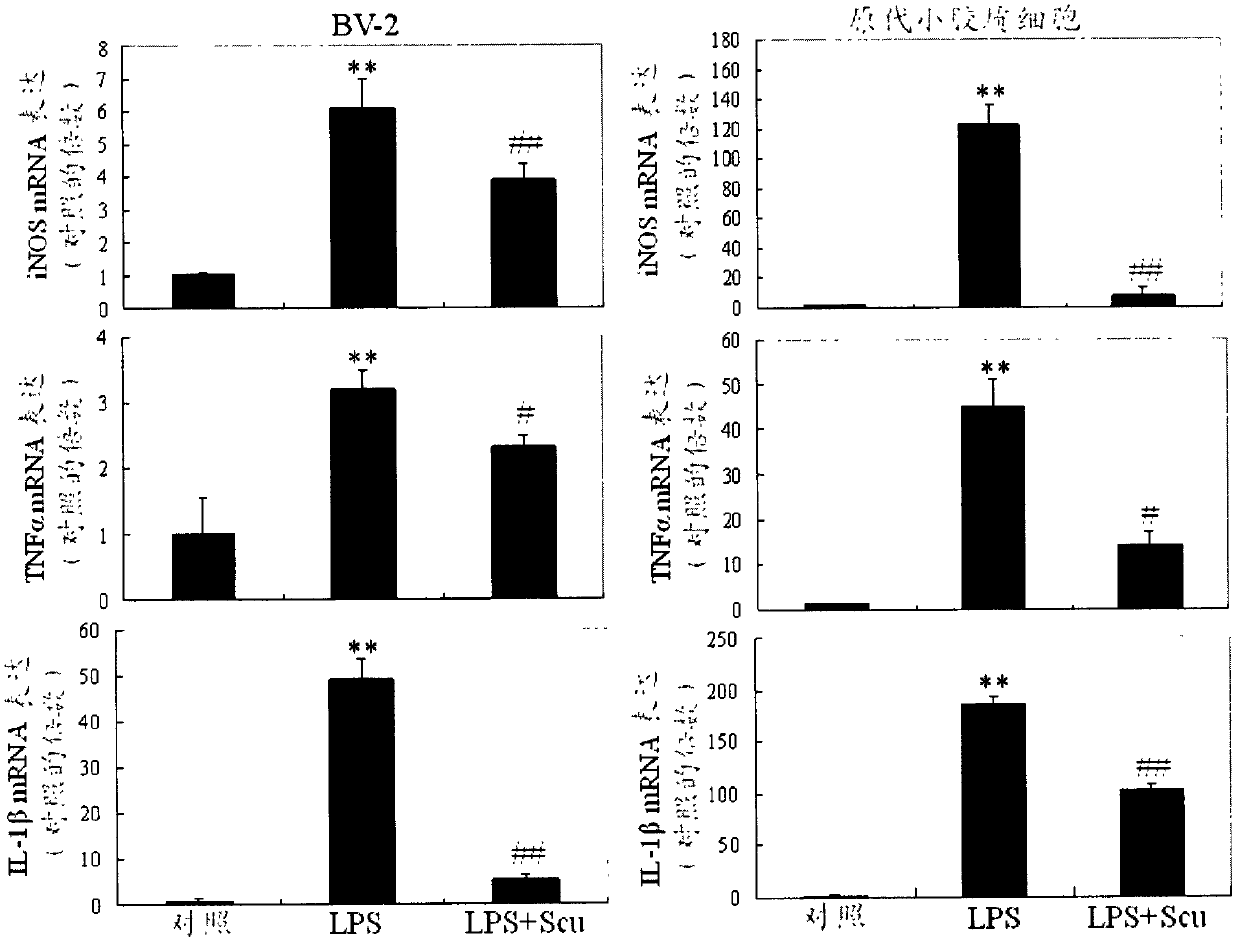Application of scutellarin to treatment of microglia-mediated diseases
A technology of microglia and scutellarin, applied in the field of scutellarin
- Summary
- Abstract
- Description
- Claims
- Application Information
AI Technical Summary
Problems solved by technology
Method used
Image
Examples
Embodiment 1
[0070] Example 1: Effect of scutellarin on secretion of inflammatory mediators by microglia
[0071] Complete DMEM medium (containing 10% fetal bovine serum, 100 U / mL penicillin and 100 μg / mL streptomycin) was used to culture mouse microglial cell line BV-2 and primary cultured rat microglial cells. Adjust cell concentration to 1 x 10 5 / mL, inoculate into 48-well culture plate overnight, add different concentrations of scutellarin (final concentration is 2, 10, 50 μmol / L) and pre-incubate for 0.5h, then add endotoxin (LPS, final concentration 0.1 μg / mL) Stimulate. Experimental groups: normal control group, LPS group and scutellarin plus LPS group. The cells were cultured for 24 hours (or 8, 12, 16, 20, 24 hours) after adding LPS, and the cell culture supernatant of each treatment group was collected, and the concentration of NO was detected by Greiss method, and the contents of cytokines TNFα and IL-1β were detected by Elisa method. The operation steps were completed acc...
Embodiment 2
[0074] Example 2: Scutellarin on the expression of iNOS, TNFα, IL-1β mRNA in microglial cells Impact
[0075] The mouse microglial cell line BV-2 and primary rat microglial cells were planted in 12-well culture plates overnight, pre-incubated with scutellarin (50 μmol / L) for 0.5 h, and then added LPS (0.1 μg / L mL) to stimulate for 8h. Wash once with PBS, and extract total cellular RNA with Trizol reagent. Samples were taken for ultraviolet detection with wavelengths of 260nm and 280nm, and the purity of total RNA was analyzed and quantified. Total RNA (0.2 μg) was reverse-transcribed into cDNA (10 μl system) using TaqMan Reverse Transcription Reagents Kit (Applied Biosystems) and oligod(T)16 primer. 0.5 μl of the cDNA product was used as template for quantitative PCR amplification. The PCR amplification reaction used SYBR Green PCR Master Mix reagent kits (Applied Biosystems), and corresponding specific primers:
[0076] mouse-GAPDH
[0077] Forward: CTTCACCACCATGGAGA...
Embodiment 3
[0102] Example 3: Effect of scutellarin on microglia ROS
[0103] Using DCFH-DA as a fluorescent probe indicating the level of intracellular ROS, the effect of scutellarin on the release of ROS from mouse BV-2 cells was studied. DCFH-DA itself does not emit fluorescence. After entering the cell, it is oxidized by ROS in the cell and emits fluorescence, thereby indicating the level of ROS in the cell. BV-2 cells were seeded in 48-well plates or 24-well plates (including coverslips). After the BV-2 cells were treated with LPS and / or scutellarin for 4 hours, the supernatant was discarded, and the cells were washed with PBS. Add DMEM medium containing DCFH-DA (10 μmol·L-1) probe to each well and continue to incubate for 30 min. Discard the supernatant, wash away the probes that have not entered the cells with PBS, add 200 μL PBS to each well, read the fluorescence value on a microplate reader, or take pictures with a laser confocal scanning microscope, the excitation wavelengt...
PUM
 Login to View More
Login to View More Abstract
Description
Claims
Application Information
 Login to View More
Login to View More - R&D
- Intellectual Property
- Life Sciences
- Materials
- Tech Scout
- Unparalleled Data Quality
- Higher Quality Content
- 60% Fewer Hallucinations
Browse by: Latest US Patents, China's latest patents, Technical Efficacy Thesaurus, Application Domain, Technology Topic, Popular Technical Reports.
© 2025 PatSnap. All rights reserved.Legal|Privacy policy|Modern Slavery Act Transparency Statement|Sitemap|About US| Contact US: help@patsnap.com



